Module 4 Fine Arts教学设计
- 格式:doc
- 大小:2.23 MB
- 文档页数:5
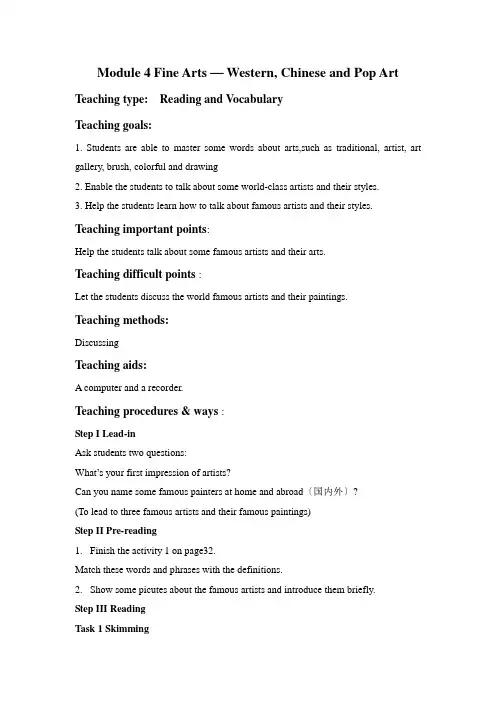
Module 4 Fine Arts — Western, Chinese and Pop Art Teaching type: Reading and VocabularyTeaching goals:1. Students are able to master some words about arts,such as traditional, artist, art gallery, brush, colorful and drawing2. Enable the students to talk about some world-class artists and their styles.3. Help the students learn how to talk about famous artists and their styles. Teaching important points:Help the students talk about some famous artists and their arts.Teaching difficult points :Let the students discuss the world famous artists and their paintings.Teaching methods:DiscussingTeaching aids:A computer and a recorder.Teaching procedures & ways :Step I Lead-inAsk students two questions:What’s your first impression of artists?Can you name some famous painters at home and abroad〔国内外〕?(To lead to three famous artists and their famous paintings)Step II Pre-reading1.Finish the activity 1 on page32.Match these words and phrases with the definitions.2.Show some picutes about the famous artists and introduce them briefly.Step III ReadingTask 1 SkimmingRead the passage quickly and then match paintings 1 -4 with descriptions in paragraphs A -D.Task 2 ScanningRead the passages carefully and answer the questions on the screen.1). True or False questions1. The Cubist art movement showed different sides of an object or person at the same time.2. Picasso started an art movement himself.3. Qi Baishi and Xu Beihong painted in different styles.4. Chinese paintings are all in black inks.5. Wu Hang likes art very much, but he sometimes get tired of looking at pictures. 2). Fill in the blankStep IV Post readingMake a summary of the text and finish the exercise.Step V Homework1. Read the text again and pick out the sentences you appreciate.2. Remember the words and phrases we have learned.3. Find more information about the artists mentioned in the text.。
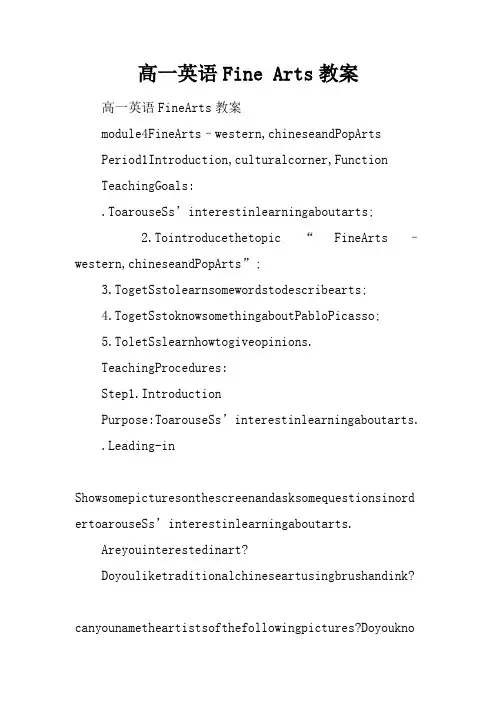
高一英语Fine Arts教案高一英语FineArts教案module4FineArts–western,chineseandPopArtsPeriod1Introduction,culturalcorner,FunctionTeachingGoals:.ToarouseSs’interestinlearningaboutarts;2.Tointroducethetopic“FineArts–western,chineseandPopArts”;3.TogetSstolearnsomewordstodescribearts;4.TogetSstoknowsomethingaboutPabloPicasso;5.ToletSslearnhowtogiveopinions.TeachingProcedures:Step1.IntroductionPurpose:ToarouseSs’interestinlearningaboutarts..Leading-inShowsomepicturesonthescreenandasksomequestionsinord ertoarouseSs’interestinlearningaboutarts.Areyouinterestedinart?Doyouliketraditionalchineseartusingbrushandink? canyounametheartistsofthefollowingpictures?Doyouknowotherfamousartistsathomeandabroad?SuggestedAnswers:Variousanswersareacceptable.Variousanswersareacceptable.Theartistsofthefourpicturesare:①DaVinci②DaVinci③XuBeihong④QiBais;otherfamousartistsare,forexample,Zhangdaqian ,PabloPicasso,VincentvanGoghandRoyLichtenstein.2.PairworkIntroducesomenewwordsbyshowingsomepictures.AskSsthefollowingquestion:Thesetwopaintsbellowareabout①.SuggestedAnswers:①※[比较]scene与sceneryscene指风景,所见之物,包括户内或户外的、城市或乡村的、活动或静态的景物。
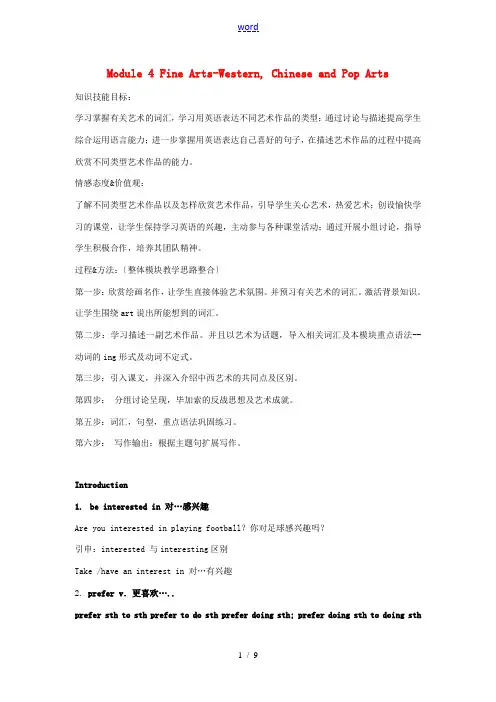
Module 4 Fine Arts-Western, Chinese and Pop Arts知识技能目标:学习掌握有关艺术的词汇,学习用英语表达不同艺术作品的类型;通过讨论与描述提高学生综合运用语言能力;进一步掌握用英语表达自己喜好的句子,在描述艺术作品的过程中提高欣赏不同类型艺术作品的能力。
情感态度&价值观:了解不同类型艺术作品以及怎样欣赏艺术作品,引导学生关心艺术,热爱艺术;创设愉快学习的课堂,让学生保持学习英语的兴趣,主动参与各种课堂活动;通过开展小组讨论,指导学生积极合作,培养其团队精神。
过程&方法:〔整体模块教学思路整合〕第一步:欣赏绘画名作,让学生直接体验艺术氛围。
并预习有关艺术的词汇。
激活背景知识。
让学生围绕art说出所能想到的词汇。
第二步:学习描述一副艺术作品。
并且以艺术为话题,导入相关词汇及本模块重点语法--动词的ing形式及动词不定式。
第三步:引入课文,并深入介绍中西艺术的共同点及区别。
第四步:分组讨论呈现,毕加索的反战思想及艺术成就。
第五步:词汇,句型,重点语法巩固练习。
第六步:写作输出:根据主题句扩展写作。
Introduction1.be interested in 对…感兴趣Are you interested in playing football?你对足球感兴趣吗?引申:interested 与interesting区别Take /have an interest in 对…有兴趣2. prefer v.更喜欢…..prefer sth to sth prefer to do sth prefer doing sth; prefer doing sth to doing sthI much prefer dogs to cats.与猫比起来,我更喜欢狗。
Many people living in cities would actually prefer to live in the country.许多住在城市的人实际上更愿意住在乡村。
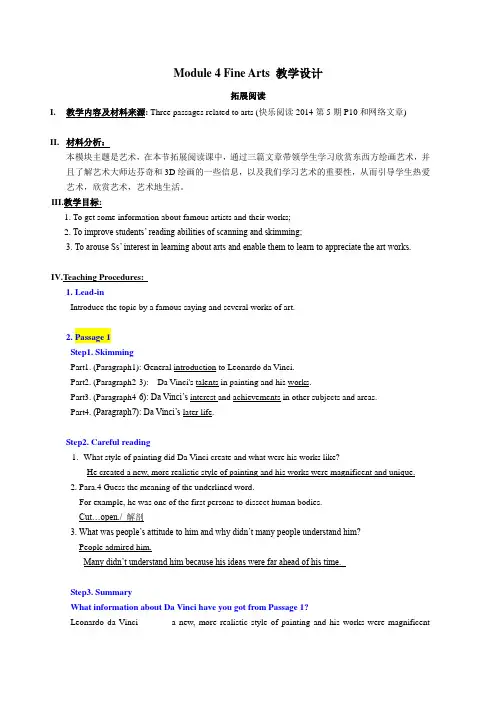
Module 4 Fine Arts 教学设计拓展阅读I.教学内容及材料来源: Three passages related to arts (快乐阅读2014第5期P10和网络文章)II.材料分析:本模块主题是艺术,在本节拓展阅读课中,通过三篇文章带领学生学习欣赏东西方绘画艺术,并且了解艺术大师达芬奇和3D绘画的一些信息,以及我们学习艺术的重要性,从而引导学生热爱艺术,欣赏艺术,艺术地生活。
III.教学目标:1. To get some information about famous artists and their works;2. To improve students’ reading abilities of scanning and skimming;3. To arouse Ss’ interest in learning about arts and enable them to learn to appreciate the art works.IV.Teaching Procedures:1. Lead-inIntroduce the topic by a famous saying and several works of art.2. Passage 1Step1. SkimmingPart1. (Paragraph1): General introduction to Leonardo da Vinci.Part2. (Paragraph2-3): Da Vinci's talents in painting and his works.Part3. (Paragraph4-6): Da Vinci’s interest and achievements in other subjects and areas.Part4. (Paragraph7): Da Vinci’s later life.Step2. Careful reading1.What style of painting did Da Vinci create and what were his works like?He created a new, more realistic style of painting and his works were magnificent and unique.2. Para.4 Guess the meaning of the underlined word.For example, he was one of the first persons to dissect human bodies.Cut…open./ 解剖3. What was people’s attitude to him and why didn’t many people understand him?People admired him.Many didn’t understand him because his ideas were far ahead of his time.Step3. SummaryWhat information about Da Vinci have you got from Passage 1?Leonardo da Vinci_______ a new, more realistic style of painting and his works were magnificentand_______, such as Mona Lisa. _______ he was talented ___ painting, he didn’t ________ his interest in other ________.Although people _______ him, ma ny didn’t understand him because his ideas were far _________his time.Answers: created unique Although in give up subjects admired ahead of3. Passage 2Step1. Lead-inShow some pictures of 3D paintings to lead to the topic.Step2. Careful reading1. Pulse of Youth _________365 meters long and _____ 2,600 _____________ of a path on the ______ of Nanjing’s Communication University of China.Answers: measures covers square meters campus2.What is more impressive about Pulse of Youth in addition to its size?What is even more impressive is that Pulse of Youth appears three-dimensional.3.What is the connection between Pulse of Youth and the upcoming Summer Youth Olympics? Pulse of Youth is created as a gift for the upcoming 2nd Summer Youth Olympics.Step3. WritingWrite a short passage down with the help of the key words.Pulse of Youth … 365 meters... 2,600 square meters……impressive… three-dimensional ……gift… Summer Youth Olympics…Possible versionCreated as a gift for the upcoming Summer Youth Olympics, Pulse of Youth measures 365 meters long and covers 2,600 square meters of a path on the campus. While the size is certainly impressive, what is even more so is that it appears three-dimensional.4.Passage 3Step1. Lead-inShow the time line and reflect art development.Step2. ScanningWhy are arts so important?( 查找有效信息,以备写作之用)Answers:gains in knowledge improvement in motivation new ways of seeing connect to the world enjoy deeper forms of beauty express ideas and beliefs reflect a state of mind, a state of lifeStep3. MessageLove art.Appreciate art.Live with art.5.HomeworkWrite a short passage about an art work you like and the reason you like it.附:阅读材料Passage 1(快乐阅读2014第5期P10)Leonardo da VinciMost of us know that Leonardo da Vinci was a great painter. However, he was also a talented sculptor, musician, poet, scientist, architect, and engineer. His work had a strong influence on artists throughout Europe, and his scientific ideas were centuries ahead of their time.Leonardo da Vinci was born in 1452 in the town of Vinci, near Florence, Italy. At the age of 15, Leonardo went to work with a famous artist. He studied painting, sculpture, music, mathematics, and science. By 20, he was a master painter. Leonardo was so talented that one day one of his teachers threw down his brushes and never painted again.Da Vinci created a new, more realistic style of painting and his works were magnificent and unique. At that time, when artists painted people, they looked flat, but da Vinci’s looked real. No other artists of his time painted people or animals as well as da Vinci did. His famous painting, the Mona Lisa, is a good example of his style. Da Vinci took four years to paint the Mona Lisa. Unfortunately, the manwho ordered the painting didn’t like it and refused to pay for him. However, ten years later, da Vincisold it to the King of France for 492 ounces of gold (about$300,000). The King hung it in the Louvre palace in Paris. Today the Mona Lisa still hangs in the Louvre, which is now a museum.Although da Vinci was a great painter, he never gave up his interest in other subjects. He liked to do research in many different areas. He wanted to understand everything he saw. Many people think of him as the first modern scientist because he liked to make observations and look for explanations for things. For example, he was one of the first people to dissect human bodies. He cut the bodies open in order to figure out how they worked. Da Vinci wrote down all his ideas and observations in notebooks. He also filled the notebooks with more than 5,000 drawings of plants, animals, and the human body. Da Vinci was a great inventor, too. His scientific research and knowledge of architecture and mathematics helped him to design many new things. For example, he drew a flying machine 400 years before the airplane was invented. He also designed an air conditioner, an alarm clock, a reading lamp, a bridge, and many other things. In all, da Vinci designed more than 1,000 inventions. Unfortunately, he did not have time to develop many of his ideas.During his lifetime, da Vinci traveled to all the great cities of Italy and did many different kinds of works. Once, when he was trying to get a job, he made a list of 36 different jobs he could do. In addition to working as artist, he had also worked as an architect and engineer. He designed buildings and canals, and he figured out how to change the direction of rivers.Later in life, da Vinci went to Rome to work for the pope. However, he was unhappy there because the younger artists were given more work than he was. As da Vinci grew older, he stayed alone more and more. Although people admired him, many didn’t understand him because his ideas were far ahead of his time. Da Vinci spent the last years of his life working for King Francis I of France. He made architectural designs, worked on engineering projects, and entertained the king with all his ideas. He also worked on his notebooks so they could be published after his death. Da Vinci died peacefully on May 2, 1519, at the age of 67.Step1Part1.(Paragraph1): General__________ to Leonardo da Vinci.Part2.(Paragraph2-3): Da Vinci's _______in painting and his______.Part3.(Paragraph4-6): Da Vinci’s _______ and ___________ in other subjects and areas.Part4.(Paragraph7): Da Vinci’s _______.Step 2 Careful-reading1. What style of painting did Da Vinci create and what were his works like?2. Para.4 Guess the meaning of the underlined word.For example, he was one of the first persons to dissect human bodies.3. What was people’s attitude to him and why didn’t many people understand him?Step3 Discussion:What information about Da Vinci have you got from Passage 1?Leonardo da Vinci_______ a new, more realistic style of painting and his works were magnificent and_______, such as Mona Lisa. _______ he was talented ___ painting, he didn’t ________ his interest in other ________. Although people _______ him, many didn’t understand him because his ideas were far _________his time.Passage 2The world’s largest and longest 3D street paintingThe world-famous Chinese artist Yang Yongchun (杨永春) showed his biggest work of art yet. Named Pulse of Youth(“青春的律动”), the 3D street painting that received two Guinness World Record titles—for the largest and longest street painting in the world—measures 365 meters long and covers 2,600 square meters of a path on the campus of Nanjing’s Communication University of China(南京中国传媒大学) . Its creators led by famous Chinese artist Yang Yongchun were awarded the certificate by the Guinness World Records at a ceremony held in the university.The painting took the team of artists 20 days to complete. According to Yongchun, the painters worked continuously from early morning to late evening, stopping only when it was too dark to tell the colors apart. Created as a gift for the upcoming 2nd Summer Youth Olympics that are scheduled to take place in Nanjing from August 16th-28th,2014, the painting describes the games complete with its mascot(吉祥物) Lele as well as the impressive architectural landscape of Nanjing and the Yangtze River that runs through it.While the size is certainly impressive, what is even more so is that Pulse of Youth appears three-dimensional. Before this, the record for the longest and largest 3D street painting belonged to British artist Joe Hill who created a 348-ft 9-inch long masterpiece that covered 12,490 square feet of London’s Canary Wharf on November 17th, 2011, to celebrate Guinness World Record Day.Not surprisingly, the longest street painting that will be open to the public for the next two months, is a big hit among the university students, who think that it is so much better to look at, than boring gray asphalt(沥青).1.Pulse of Youth _________365 meters long and _____ 2,600 square meters of a path on the ______of Nanjing’s Communication University of China.2. What is more impressive about Pulse of Youth in addition to its size?3. What is the connection between Pulse of Youth and the upcoming Summer Youth Olympics?4.Write a short passage down with the help of the key words.Pulse of Youth … 365 meters... 2,600 square meters……impressive… three-dimensional ……gift… Summer Youth Olympics…Passage 3The Power of ArtsInvolvement in the arts is associated with gains in knowledge and improvement in motivation (积极性,动机)and so on. A 2005 report by the Rand Corporation showed that art experience can connect people more deeply to the world and open them to new ways of seeing. Arts initiatives are taking root in a growing number of school districts to teach students to be human beings who can enjoy the deeper forms of beauty.Throughout the ages art has played a crucial role in life. Art is universal and we can experience it on a daily basis — from the houses we live in (architecture) to the movies we see (theatre) to the books that we read (literature).Art is everywhere, it and we are closely related, it impacts our lives through our life.Most art is created for a specific reason or purpose, and it has a way of expressing ideas and beliefs. Art can reflect a state of mind, a state of life in this colorful world.Why are arts so important?Because it can lead to ____________, ________________, ______________ and help ________________, ___________________, ____________________, _____________________.。
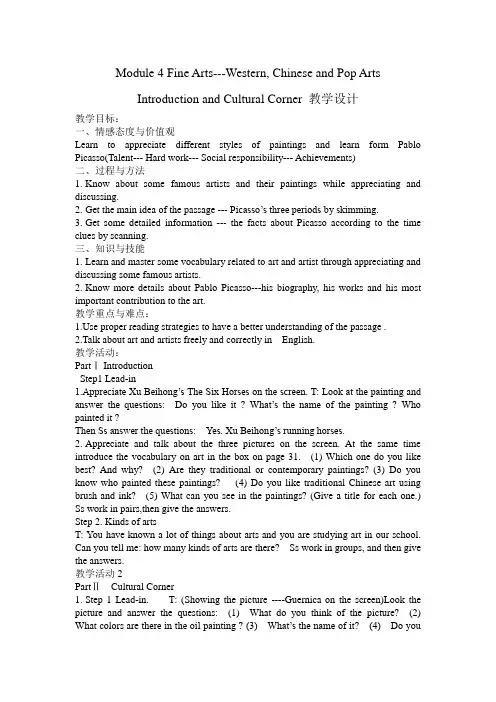
Module 4 Fine Arts---Western, Chinese and Pop ArtsIntroduction and Cultural Corner 教学设计教学目标:一、情感态度与价值观Learn to appreciate different styles of paintings and learn form Pablo Picasso(Talent--- Hard work--- Social responsibility--- Achievements)二、过程与方法1.Know about some famous artists and their paintings while appreciating and discussing.2.Get the main idea of the passage --- Picasso’s three periods by skimming.3.Get some detailed information --- the facts about Picasso according to the time clues by scanning.三、知识与技能1.Learn and master some vocabulary related to art and artist through appreciating and discussing some famous artists.2.Know more details about Pablo Picasso---his biography, his works and his most important contribution to the art.教学重点与难点:e proper reading strategies to have a better understanding of the passage .2.Talk about art and artists freely and correctly in English.教学活动:PartⅠ IntroductionStep1 Lead-in1.Appreciate Xu Beihong’s The Six Horses on the screen. T: Look at the painti ng and answer the questions: Do you like it ? What’s the name of the painting ? Who painted it ?Then Ss answer the questions: Yes. Xu Beihong’s running horses.2.Appreciate and talk about the three pictures on the screen. At the same time introduce the vocabulary on art in the box on page 31. (1) Which one do you like best? And why? (2) Are they traditional or contemporary paintings? (3) Do you know who painted these paintings? (4) Do you like traditional Chinese art using brush and ink? (5) What can you see in the paintings? (Give a title for each one.) Ss work in pairs,then give the answers.Step 2. Kinds of artsT: You have known a lot of things about arts and you are studying art in our school. Can you tell me: how many kinds of arts are there? Ss work in groups, and then give the answers.教学活动2PartⅡCultural Corner1.Step 1 Lead-in. T: (Showing the picture ----Guernica on the screen)Look the picture and answer the questions: (1) What do you think of the picture? (2) What colors are there in the oil painting ? (3) What’s the name of it? (4) Do youknow who painted it? (5) How much do you know about Picasso? Suggested Answers:(1) Cubic , horrible ,… (baby ---dead mother---- crying ox--- horse---- lamp--- flower---- solider---- )教学活动31 Step2 SkimmingT: Read the passage and fill in the table. What do we learn about (a) Picasso’s blue period (b) Picasso’s pink period (c) Picasso and Cubism?Ss work individually, and then check the answers.Step 3 ScanningT:Scan the passage and find out what he did in the following time Let’s have a competition . Boy’s group and girl’s group: Ss work in two groups: Boy’s group and girl’s group.Then check the answers. (on the screen). 1. In 1881__________________ 2. At the age of ten_________________ 3.At the age of 16_________________ 4. In his early twenties________________ 5 .From 1902 to 1904_________________ 6. From 1904 to 1906________________ 7 In 1937__________________ 8. In 1973_________________________Step 4 Discussion1.Why did Picasso paint Guernica?2. What should we learn from Picasso? Ss discuss in groups, and then give the answers. Suggested Answers: 1.All arts are based on people ,he care about his hometown and people there. 2.Talent----- Hard work------ AchievementStep 5 SummaryWhat have we learnt in this period? Suggested Answers:Some words about art and artist. Something about Picasso----his study and life experience, his paintings and great achievement.Homework:1. Recite the words learned in this period.2. Try to retell the passage according to the time clues (选做).3. Preview Reading and V ocabulary to know other painters and paintings on P32.4. Search for some information about “Pop Arts” and “Cubism”.。
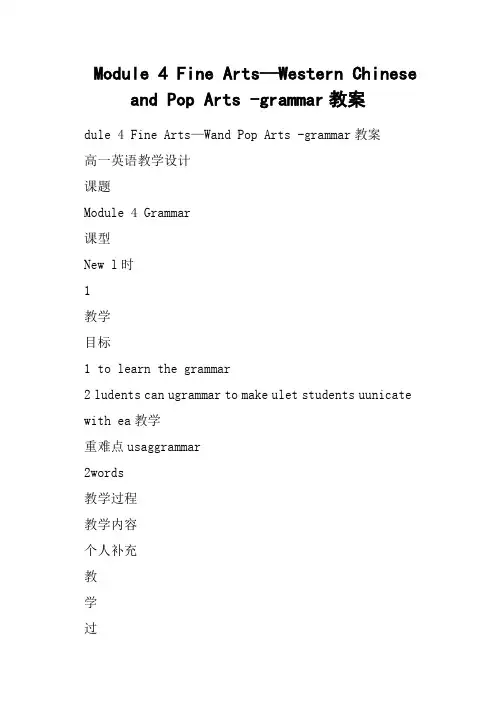
Module 4 Fine Arts—Western Chinese and Pop Arts -grammar教案dule 4 Fine Arts—Wand Pop Arts -grammar教案高一英语教学设计课题Module 4 Grammar课型New l时1教学目标1 to learn the grammar2 ludents can ugrammar to make ulet students uunicate with ea教学重难点usaggrammar2words教学过程教学内容个人补充教学过程greetingStep2 lead-三维目标:1. 知识与技能Enlarge andudents’ grammatical knowledge.2.过程与方法Study and discuss to magramma情感与价值1) Feeling fun bating w2) Raisingative awaur study by pair work or group work.Important and difficul:1. Leaarch bation.2. Learn to make suusage of –ing form andve.3. How to take an active part in class.4. How to use –ing form andve.学法指导:自主学习,学会预习;合作学习,探讨问题;展示成果,发现不足。
知识链接:Knowledge learned before(阅读练习册P47)1. 写出只接-ing形式作宾语的动词和汉语意思。
avoid, appreciate, adder, dxcuse, escaagdauggest, stand2. 写出常接-ing形式作宾语的动词短语和汉语意思。
be good at, be fond of, be worth, devl like, give up, have trouble/difficullead to, leave off, look forward to, obay au写出只接不定式to do作宾语的动词和汉语意思。
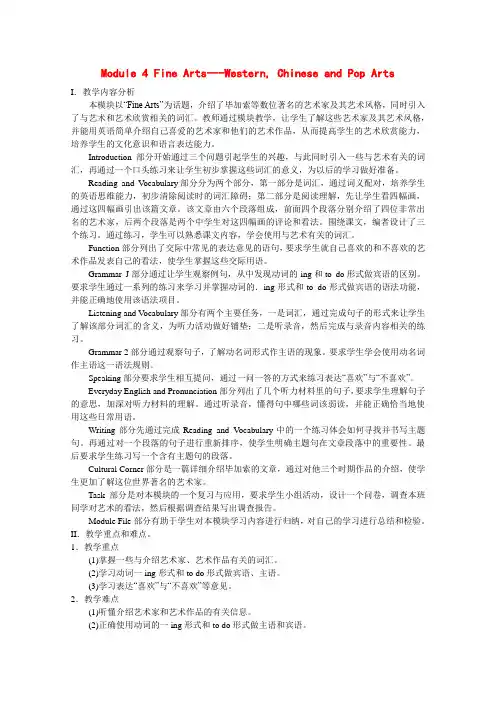
Module 4 Fine Arts---Western, Chinese and Pop ArtsI.教学内容分析本模块以“Fine Arts”为话题,介绍了毕加索等数位著名的艺术家及其艺术风格,同时引入了与艺术和艺术欣赏相关的词汇。
教师通过模块教学,让学生了解这些艺术家及其艺术风格,并能用英语简单介绍自己喜爱的艺术家和他们的艺术作品,从而提高学生的艺术欣赏能力,培养学生的文化意识和语言表达能力。
Introduction部分开始通过三个问题引起学生的兴趣,与此同时引入一些与艺术有关的词汇,再通过一个口头练习来让学生初步掌握这些词汇的意义,为以后的学习做好准备。
Reading and V ocabulary部分分为两个部分,第一部分是词汇,通过词义配对,培养学生的英语思维能力,初步清除阅读时的词汇障碍;第二部分是阅读理解,先让学生看四幅画,通过这四幅画引出该篇文章。
该文章由六个段落组成,前面四个段落分别介绍了四位非常出名的艺术家,后两个段落是两个中学生对这四幅画的评论和看法。
围绕课文,编者设计了三个练习。
通过练习,学生可以熟悉课文内容,学会使用与艺术有关的词汇。
Function部分列出了交际中常见的表达意见的语句,要求学生就自己喜欢的和不喜欢的艺术作品发表自己的看法,使学生掌握这些交际用语。
Grammar J部分通过让学生观察例句,从中发现动词的-ing和to do形式做宾语的区别。
要求学生通过一系列的练习来学习并掌握动词的.ing形式和to do形式做宾语的语法功能,并能正确地使用该语法项目。
Listening and V ocabulary部分有两个主要任务,一是词汇,通过完成句子的形式来让学生了解该部分词汇的含义,为听力活动做好铺垫;二是听录音,然后完成与录音内容相关的练习。
Grammar 2部分通过观察句子,了解动名词形式作主语的现象。
要求学生学会使用动名词作主语这一语法规则。
Speaking部分要求学生相互提问,通过一问一答的方式来练习表达“喜欢”与“不喜欢”。
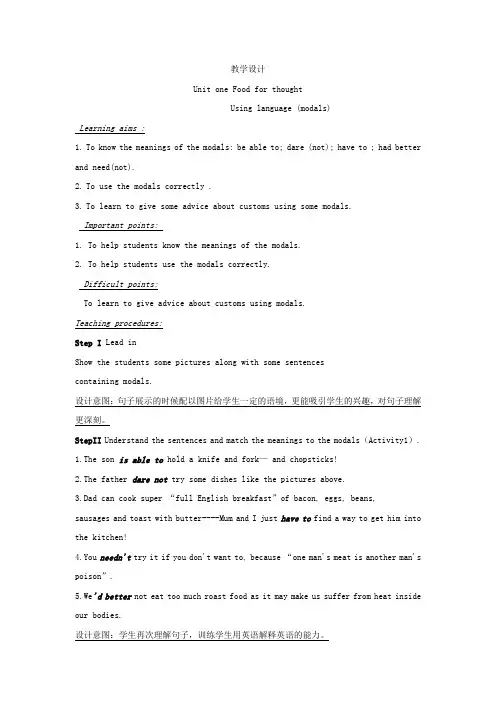
教学设计Unit one Food for thoughtUsing language (modals)Learning aims :1.To know the meanings of the modals: be able to; dare (not); have to ; had better and need(not).2.To use the modals correctly .3.To learn to give some advice about customs using some modals.Important points:1.To help students know the meanings of the modals.2.To help students use the modals correctly.Difficult points:To learn to give advice about customs using modals.Teaching procedures:Step I Lead inShow the students some pictures along with some sentencescontaining modals.设计意图:句子展示的时候配以图片给学生一定的语境,更能吸引学生的兴趣,对句子理解更深刻。
StepII Understand the sentences and match the meanings to the modals(Activity1).1.The son is able to hold a knife and fork— and chopsticks!2.The father dare not try some dishes like the pictures above.3.Dad can cook super “full English breakfast”of bacon, eggs, beans, sausages and toast with butter----Mum and I just have to find a way to get him into the kitchen!4.You needn't try it if you don't want to, because “one man's meat is another man's poison”.5.We'd better not eat too much roast food as it may make us suffer from heat inside our bodies.设计意图:学生再次理解句子,训练学生用英语解释英语的能力。
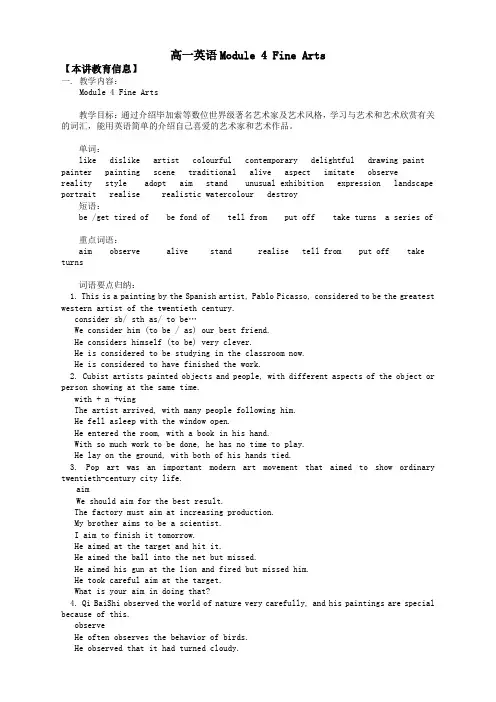
高一英语Module 4 Fine Arts【本讲教育信息】一. 教学内容:Module 4 Fine Arts教学目标:通过介绍毕加索等数位世界级著名艺术家及艺术风格,学习与艺术和艺术欣赏有关的词汇,能用英语简单的介绍自己喜爱的艺术家和艺术作品。
单词:like dislike artist colourful contemporary delightful drawing paint painter painting scene traditional alive aspect imitate observereality style adopt aim stand unusual exhibition expression landscape portrait realise realistic watercolour destroy短语:be /get tired of be fond of tell from put off take turns a series of重点词语:aim observe alive stand realise tell from put off take turns词语要点归纳:1. This is a painting by the Spanish artist, Pablo Picasso, considered to be the greatest western artist of the twentieth century.cons ider sb/ sth as/ to be…We consider him (to be / as) our best friend.He considers himself (to be) very clever.He is considered to be studying in the classroom now.He is considered to have finished the work.2. Cubist artists painted objects and people, with different aspects of the object or person showing at the same time.with + n +vingThe artist arrived, with many people following him.He fell asleep with the window open.He entered the room, with a book in his hand.With so much work to be done, he has no time to play.He lay on the ground, with both of his hands tied.3. Pop art was an important modern art movement that aimed to show ordinary twentieth-century city life.aimWe should aim for the best result.The factory must aim at increasing production.My brother aims to be a scientist.I aim to finish it tomorrow.He aimed at the target and hit it.He aimed the ball into the net but missed.He aimed his gun at the lion and fired but missed him.He took careful aim at the target.What is your aim in doing that?4. Qi BaiShi observed the world of nature very carefully, and his paintings are special because of this.observeHe often observes the behavior of birds.He observed that it had turned cloudy.Did you observe anything strange?She observed a man walking on the opposite side of the way.They didn’t observe Tom come in and go upstairs.SpecialWhat’s your special subject?He has a special talent for physics.This is a special tool for digging holes.5. He is most famous for his lively paintings of horses.They look so alive.alive/living /live/livelyThe snake is alive /living.The living/live snake has been put into a basket.A living language should be learned orally.They caught a snake alive.He was alive when he was taken to hospital.The dead are always remembered by the living.I feel everything here is very lively.His class is lively and interesting.Did you watch the live football match on TV?6. I enjoyed it a lot, although I can get tired of looking at pictures all the time.althoughAlthough he is old, yet he looks very strong and healthy.Although it was snowing, it was not very cold.I was late for the first train although I hurried.Although he was tired, he kept on working.get/be tired ofHe is tired of reading the text again and again.Are you tired of carrying around a heavy laptop computer?He was tired of answering his little son’s continual questions.I’m tired o f fried eggs.be tired of / be tired fromI’m very tired from running as fast as I can.I’m tired from climbing the mountains.7. I can tell by the style.tellCall you tell the difference between the two words?I can’t tell which bag is her s.We can tell a flight attendant by her uniform.tell one from anotherIt’s sometimes hard to tell one twin from the other.The children can’t tell one from the other.byA blind man can know what something is by feeling and touching.He made a living by begging from door to door.We must improve our life by the development of science.8. I can’t stand that picture of a golden-haired girl.standI can’t stand the hot weather.I can’t stand the noises being made by the boys.We can’t stand breathing such dirty air.I can’t stand to wait any longer.Support/ bear/standI can’t bear/stand this pain.Is this bridge strong enough to support/bear heavy lorries?He lost the support of the nation.9. Instead, a pictu re should attempt to show the ‘life’ of its subject.attemptShe attempted to go on with her work in the house. But she could not.He attempted many scientific experiments.After repeated attempt they finally succeeded.Make an attempt to do sth/ at doing sthThe prisoner attempted to escape.The prisoner attempted an escape / to escape but failed.He made an attempt / attempted to learned to ski.10. Take turns to ask your questions.take turns to do sth = take one’s turn to do sthEveryone took his turn to speak.It’s one’s turn to do sthIt’s my turn to clean the room.It’s your turn to recite the text.11. Chinese sentences tend to be shorter.tendI tend to go to bed earlier during the winter.Women tend to live longer than men.It tends to rain a lot in summer here.He tends to get angry when people can’t agree to his plan.Every country tends to accept its own way of life as being the normal one.Schools in the south tend to be better equipped, while those in the north are relatively poor.The nurse skillfully tended their wounds.12. realizeOnly then did he realize his mistakes.Man begins to realize the danger of nuclear war.He didn’t realize it was dark until he looked out of the window.More and more people realize the importance of learning a foreign language well.It has inspired many of them to believe that they can realize their dreams.She managed to realize her dream at last.13. She put off showing my pictures to people until they are finished.put offThey put off the picnic because of the rain.We decided to put off the trip to the U.S.They will put off their dinner until 8.I put off writing to you till today just because I was too busy.Surely you can put it off one more week.语法知识学练:1. to-do & ving as objectwords only followed by vingadmit appreciate avoid complete consider delay enjoy escape prevent finish imagine mind miss practice recall resist risk suggest stand forgive keep be used to lead to devote oneself to object to stick to look forward t o can’t help it’s no use/ good be tired of be fond of be afraid of be proud of think of/about put off keep on insist on set about be successful in be good at give up burst out prevent… from…words only followed by to dodecide desire expect hope mean pretend promise refuse want wish agree manage2. Some sentence structure in which ving used as subject(1) doing… + vReading is an art.Seeing is believing.(2) It is + no use, no good (fun, a great pleasure, a waste of,) and so on +doing sth.It is no use crying.It is a great fun playing football.It is a waste of time trying to explain.(3) It is + useless (nice, good, interesting, expensive) and so on + doing sth.It is useless speaking.It is nice seeing you again.It is good playing chess after supper.It is expensive running this car.(4) There is no + doing.There is no telling what he is going to do.There is no saying what may happen.(5) There is no use (good, point, sense, harm) + doing sth.There is no use crying over spilt milk.【模拟试题】一. 词组翻译对……厌烦_________________喜欢,喜爱 _________________依据……识别 _________________推迟,延期 _________________轮流 _________________一系列的 _________________把……认为是 _________________目标是_________________对……产生兴趣_________________同时_________________因为,由于________________一直 _________________热衷的,热爱的 _________________前进,继续________________在某人20多岁时___________________一类,一种 _________________和……混合_________________盼望__________________成功做__________________放弃________________二. 词语活用1. I have been_________(绘画) all the day.2. It is __________ (不寻常)for you to catch cold.3. Smile can be friendly ________(表达)4. Many _______(当代的) inventions are of great importance.5. There will be an _______ (展览)of famous paintings in the hall.三单项选空1. The officers narrowly escaped ______ in the hot battle.A have killedB to killC to be killedD being killed2. People couldn’t help ______ the foolish emperor in the procession.A laugh atB to laugh atC laughing atD laughing on3. We’re looking forward ______ the photo exhibition.A to visitingB to visitC to having visitedD visiting4. How about two of us _______a walk down the garden?A to takeB takeC takingD to be taking5. Would you ______me your identification card, sir?A mind to showB mind showingC trouble to showD trouble showing6. It is no good ______ to come now. He is busy.A if you ask himB to ask himC asking himD that you ask him7. Which do you enjoy _______ your weekends, fishing or watching TV?A spendingB to spendC being spentD spend8. I can hardly imagine Peter______ across the Atlantic Ocean in 15 days.A sailB to sailC sailingD to have sailed9. Does the way you thought of _______the water clean make any sense?A makingB to makeC how to makeD having made10. It was ________ computer games that cost the boy a lot of time that he ought to have spent on his lessons.A to have playedB playingC playedD having played四. 完型填空Have you ever been at a meeting while someone was making a speech and realized suddenlythat your mind was a million miles 1 ? You probably felt sorry and made up your mindto pay attention and always 2 told that daydreaming is a waste of time.“On the contrary,” says L. Giambra, an expert in psychology, “daydreaming is quite3 .” Without it, the mind couldn’t get done all the thinking it has to do during a normal day. You can’t4 do all your thinking with a conscious (有意识) mind . Instead, your unconscious mind is5 problems all the time. Daydreaming then may be one waythat the unconscious and conscious states of mind have 6 dialogues.Early experts in psychology paid 7 attention to the importance of daydreamsor even considered them harmful. At one time daydreaming was thought to be a cause of some 8 illnesses. They did not have a better 9 of daydreams until the late 1980s. Eric Klinger, a professor of psychology, is the 10 of the book Daydreaming. Klinger says, “We know now that daydreaming is one of the 11 ways that we organize our lives, learn from our experiences, and plan 12 our futures. Daydreams really area window on the things we fear and the things we 13 in l ife.”Daydreams are usually very simple and direct, quite 14 sleep dreams, which maybe hard to understand. It’s easier to 15 a deep understanding of your life by paying close attention to your daydreams 16 by trying to examine your sleep dreams carefully. Daydreams help you recognize the difficult situations in your life and 17 a possible way of dealing with them.Daydreams cannot be predicated (预料). They move of in unexpected 18 , which may be creative and 19 ideas. For many famous artists and scientists, daydreams were and are a main 20 of creative energy.1. A. far B. long C. away D. over2. A. has been B. have been C. had been D. were3. A. possible B. smooth C. fine D. necessary4. A. likely B. fairly C. possibly D. naturally5. A. working out B. working at C. working for D. working on6. A. usual B. exciting C. aloud D. silent7. A. a little B. much C. no D. some8. A. physical B. minding C. feeling D. mental9. A. thought B. sense C. understanding D. scene10. A. author B. reporter C. printer D. designer11. A. unusual B. main C. natural D. common12. A. with B. on C. beyond D. for13. A. long for B. want to C. think up D. would like14. A. dislike B. like C. unlike D. likes15. A. earn B. receive C. accept D. gain16. A. and B. so C. than D. or17. A. look out B. find out C. keep out D. pick out18. A. distance B. situation C. roads D. directions19. A. full of B. unreasonable C. fond of D. correct20. A. place B. imagination C. thought D. source五. 阅读理解Traveling is a very good activity. When you are fed up with your work and when you can get a holiday, you can go to the beautiful spots to enjoy the beauty of nature and the special character of other cities. You can breathe fresh air, visit some places of interest, meet different people and make friends with them. If you do so, you will forget your tiredness and troubles and build up your health. As a result, you will feel fully relaxed and you will have the energy to undertake the new tasks waiting for you.But sometimes, traveling is not an enjoyable thing. For example, when the bus or car you take has a bad accident, you just sit in and wasted your time. What’s more, the weather can be changeable. If you are climbing a mountain, it may rain suddenly. You may be caught in the rain and may catch a cold. The worst thing is that you may have your money stolen and you may have an injury. All these are terrible things that can happen to a tourist.Therefore, when you are going on a trip, you must prepare yourself carefully. Firstly, you must have clear information about the weather. Secondly, you should choose a good companion so that you can help each other. Thirdly, you must be careful everywhere and try to avoid accidents. If you do this, you’ll surely enjoy your travels and avoid any unnecessary trouble.1. In the passage, the author suggests that you should for a holiday.A. go to the countryB. go to different citiesC. go nowhereD. both A and B2. In the first paragraph, the underlined words “are fed up with” means_________.A. finish doingB. can’t doC. are tired ofD. are interested in3. What is NOT mentioned in the passage?A. You may meet with unexpected troubles on a trip.B. You may get ill on a trip.C. You will have to spend a lot of money on a bus or in a car.D. It’s necessary for you to know about the weather before you travel.4. In order to have a good holiday, you should .A. be careful enoughB. have a holiday with a good friendC. take an umbrella with youD. be well prepared for your trip六. 短文改错Construction of a television tower that declared to be the world’s 1.tallest is due to starting in the capital of Guangdong Province. This 2. tower , which could be up to 600 meter tall , is expected to be a new 3. tourist attraction , competing with the 320-meter-high Eiffel Tower in 4. Paris and the 468-meter-high Oriental Pearl Radio or TV Tower in 5. Shanghai. The local government is present busy selecting a design from 6. three foreign companies that had entered the final round of competition. 7. They come to Germany, Britain and France. All the three designs for 8.the new tower require for the project to reach between 580 meters and 9.600 meters and the project is expected to be completing and open to 10. tourists between August and September 2007.试题答案一. 词组翻译:be/get tired of be fond of tell by put off take turns a series of consider… to be aim to develop an interest in at the same time becauseof all the time be crazy about go on in one’s twenties a styleof be mixed with look forward to succeed in give up二. 词语活用:painting unusual expression contemporary exhibition三. 单项填空:DCACB CBCBB四. 完型填空:1—5CBDCA 6—10DCDCA11—15BDACD 16—20CBDAD五. 阅读理解DCCD六. 短文改错:1. that 后面加is2. starting →start3.meter→meters4.√5. or → and6. present →presently7. had → have 8. to → from 9. 去掉for10. completing → completed。
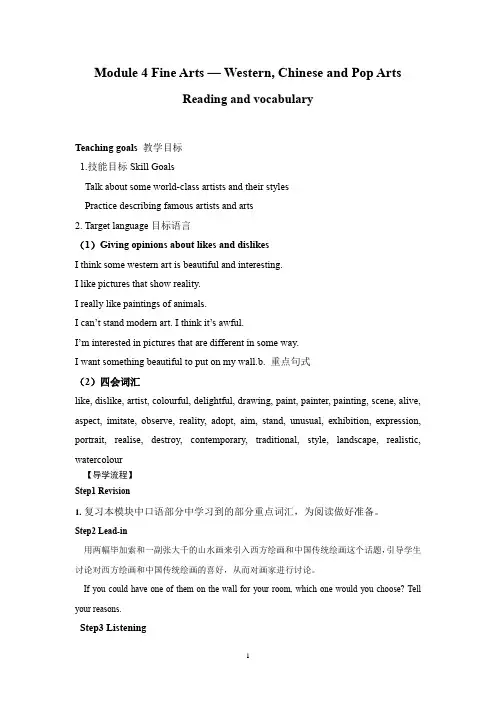
Module 4 Fine Arts — Western, Chinese and Pop ArtsReading and vocabularyTeaching goals教学目标1.技能目标Skill GoalsTalk about some world-class artists and their stylesPractice describing famous artists and arts2. Target language目标语言(1)Giving opinions about likes and dislikesI think some western art is beautiful and interesting.I like pictures that show reality.I really like paintings of animals.I can’t stand modern art. I think it’s awful.I’m interested in pictures that are different in some way.I want something beautiful to put on my wall.b. 重点句式(2)四会词汇like, dislike, artist, colourful, delightful, drawing, paint, painter, painting, scene, alive, aspect, imitate, observe, reality, adopt, aim, stand, unusual, exhibition, expression, portrait, realise, destroy, contemporary, traditional, style, landscape, realistic, watercolour【导学流程】Step1 Revision1.复习本模块中口语部分中学习到的部分重点词汇,为阅读做好准备。
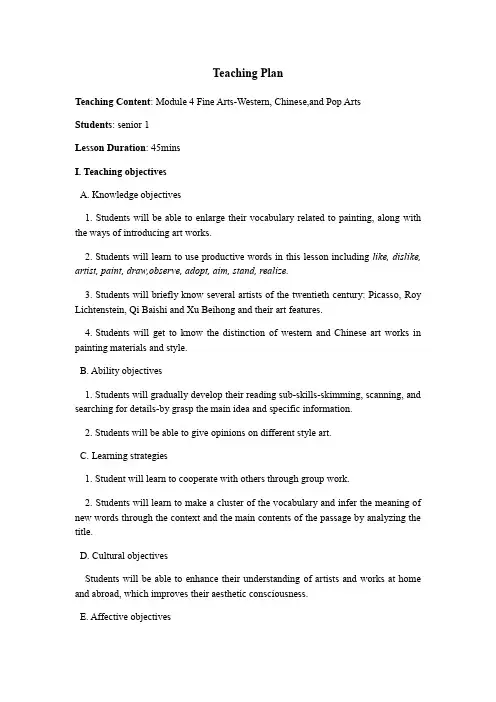
Teaching PlanTeaching Content: Module 4 Fine Arts-Western, Chinese,and Pop ArtsStudents: senior 1Lesson Duration: 45minsI. Teaching objectivesA. Knowledge objectives1. Students will be able to enlarge their vocabulary related to painting, along with the ways of introducing art works.2.Students will learn to use productive words in this lesson including like, dislike, artist, paint, draw,observe, adopt, aim, stand, realize.3.Students will briefly know several artists of the twentieth century: Picasso, Roy Lichtenstein, Qi Baishi and Xu Beihong and their art features.4.Students will get to know the distinction of western and Chinese art works in painting materials and style.B. Ability objectives1. Students will gradually develop their reading sub-skills-skimming, scanning, and searching for details-by grasp the main idea and specific information.2. Students will be able to give opinions on different style art.C. Learning strategies1. Student will learn to cooperate with others through group work.2. Students will learn to make a cluster of the vocabulary and infer the meaning of new words through the context and the main contents of the passage by analyzing the title.D. Cultural objectivesStudents will be able to enhance their understanding of artists and works at home and abroad, which improves their aesthetic consciousness.E. Affective objectivesStudents’ interest and appreciations in art will be stimulated.II. Teaching focal points:Students will be able to develop reading skills----skimming, scanning, and searching for details and master the style of artists.III. Teaching difficult points:Students search for details and give opinions on art works individually.IV. Teaching methodology: TBLT &PWPV. Teaching aids: Multimedia, blackboardVI. Teaching proceduresStep1. Lead-in (3’)After greeting students, teacher presents Picasso’s a art work to students, and asks them several questions related to the work.Q1. Have you ever seen this painting in any books? Do you know its artist? Which art movement does it belong to?Q2. What other artists and their works do you know of Western or Chinese?(Purpose of design: This step is to activate the class atmosphere and stimulate Ss’ schema.)Step2.Pre-reading(7’)Teacher highlights the title and present the task. Afterwords, some new will beshown in a short passage.Activity1.Teacher highlights the title and asks students to predict the contents of the article.Activity2. Present the task in power point.Activity3. Introduce some new words by a cluster of vocabulary about art. Then,students read in chorus.(Purpose of design: This step aims at helping students get familiar with new words and laying the foundation for learning the text, as the scaffolding of comprehending the whole text in the next step.)Step3.While-reading(24’)Students will be guided to get a good grip of four artists and their works’ features.Activity1. Fast reading1. Guide students to skim for the main idea.Look at the title, you can get it talks about…(Ss’ answer)2. Ask students to scan for specific information.Q1. Now please quickly scan the text, which artists are involved in this article?Q2. What century did these artists belong to?(Purpose of design: This step helps train the students to read fast.)Activity2. Close readingTeacher guide students to read text carefully and master the artists and art.1.Focusing on passage A-DStudents will be divided into 6 groups and they need fill the table according to passage A-D. Then four groups will be invited to share their answer with us. After that, teacher will integrate the four table and make a brief summary. Students will be required to finish exercise 2 (1) in page 32.2.Focusing on passage E-F.Students read the last two passages and seize Wu Hang and Sarah Hardwick’s opinion on different art works.Q1. Does Wu Hang like Qi Baishi’s paintings?Q2. What does he think of the picture of a golden-haired girl?Q3. How does Sarah Hardwick like Xu’s painting?Q4. Dose she like Picasso? And what does she think of him?(Purpose of design: This design is to train students’ ability of gaining detailed information and cooperative ability.)Step4.Post-reading(7’)Students will be guided to analyze the distinction of Western and Chinese art of twentieth century briefly based on four pictures provided by teacher. Then, they will give their opinions or preference for the western and Chinese paintings.Activity1: Four pictures presented on the slide will help students tell the western and Chinese paintings in brief.T: There are four pictures, and can you tell western paintings from Chinese paintings? How do you tell it?(Purpose of design: This is to associate students to know the distinction of western and Chinese art works in painting materials and style.)Activity2. Students will give their opinions or preference for the western and Chinese paintings.T: I think you have got a brief understanding of western and Chinese paintings, so which do you prefer?(Purpose of design: This part of activity is designed to train students to give opinions on different style art and promote their spoken English.)Step5. Summary(2’)Teacher will guide students to make a short summary about the article.(Purpose of design: This step is to consolidate what they have learned in class.Step6.Homework(2’)(Purpose of design: This step aims at removing the scaffolding and encouraging students to implement task.)VII. Blackboard design。
Module 4 Fine Arts—Western Chinese and Pop ArtsIntroduction,reading and vocabulary教案Part1 IntroductionStep1 preparationShow some fine pictures to the students and have a discussion on art by ask some questions such as1. Are you interested in art?2. Can you name a great nineteenth-century Chinese artist?3. Do you like traditional Chinese art using brush and ink?Step2 Learn some key wordsartist: a person who produces works of art, esp. paintings.art gallery: a room, hall or building where works of art are shownbrush:an instrument for cleaning or paintingcolourful:brightly coloured; full of colourcontemporary:modern; belong to the present timedelightful:very pleasingdraw:make a picture of sth with a pencil or brushdrawing: the art of making pictures with a pencil or penink: coloured liquid used for writing, printing or drawingpaint:to paint picturespainter: a person who paint picturespainting: picturesscene: a single piece of action in one place; a place seen (as if) in a picture traditional: being traditionStep3 Enjoy three key pictures1.Which one do you prefer?2.Give a title for each one.Picture1a quiet girl a lean girl a sad girl a thoughtful girla pondering girlPicture2 a good place for seclusion a good place for relaxingthe beautiful countryside the peaceful countrysidethe quiet countrysidePicture3cold winter withered willow treeswater oxen / buffalos a desolate scenee two or three sentences to describe what you think about it?Picture1Picture2Picture3Part2 Reading and vocabularyStep1 Match these words with the definitionsAlive aspect imitate (art) movement observe ordinary reality style1.The way in which something is done style2. To watch carefully observe3. A style of painting adopted by a group of artists movement4. To copy imitate5.Living or full of life alive6. Not special or unusual ordinary7.One of the separate parts of something aspect8. The way something really is realityStep2 Read passages A-F, then1. Match paintings1-4 with descriptions in paragraphs A-D.2. Say which paintings are mentioned in paragraphs E and FStep3. Read paragraphs A-f again and choose the correct answer1.The Cubist art movement ______ .(a) showed different sides of an object in the same picture(b) is considered to be the greatest art movement of the twentieth century2.Pop art_________ .(a) advertised the twentieth-century life(b) tried to show ordinary life in the modern world3. Qi Baishi__________ .(a) painted in an unusual way(b) was a traditional Chinese artist4. Xu Beihong__________ .(a) wanted to do more than imitate reality(b) tried to paint horses5.Wu Hang___ the picture of a golden-haired girl. (a) loves (b)dislikes6.Sarah Hardwick thinks that___ painted picture3(a) a Chinese artist (b) Pablo PicassoStep4 Function Giving opinions(a). The following useful expressions may help you to express your opinions:I think some western art is beautiful and interesting.I like pictures that show reality. I really like paintings of animals.I can’t stand modern art. I think it’s awful.I’m interested in pictures that are different in some way.I want something beautiful to put on my wall.(b)Watch some pictures and express your opions1.Which do you like best or least? Why?2.Describe it and say what you know about itHomework1. Review the reading passage2. Write down your opinions about the pictures。
Module4FineArts-...Module 4 Fine Arts--- Western, Chinese and Pop Arts(3)教学设计Teaching goals 教学目标1. Target language 目标语言重点词汇和短语exhibition,express,landscape,portrait,realize,realistic,watercolor2. Ability goals能力目标Enable the students to express their likes and dislikes freely.3. Learning ability goals学能目标Help the students learn how to express their likes and dislikes freely.Teaching important points 教学重点Get the students to talk about their likes and dislikes.Teaching difficult points 教学难点How to encourage the students to express their likes and dislikesTeaching methods教学方法Cooperative learning and task-based activityTeaching aids 教具准备A tape recorder,a projector and some slides.Teaching procedures & ways教学过程与方式Step I RevisionT: At the beginning,let’s check the answers to the exercises of Vocabulary....Step II Listening and VocabularyTask 1 Complete the sentences with these wordsThis activity is meant to smooth away the difficulties in the listening that follows.T: Now let’s review some words. I’ll say some words in Chinese. I’d like you to tell me their meanings in English. Ready?Let’s go. “展览”,“表情,表达”,“风景画”,“油画”,“肖像,画像”,“领悟,意识到”,“现实主义的”,“水彩画”Ss: Exhibition,expression,landscape,oil painting,portrait,realize,realistic,watercolor.T: Good!Now please turn to page 36 and let’s do Activity 1. I’d like you to do it by yourselves first and then let’s check the answers together.After several minutesT: Ready?I’d like one of you to read out the sentences and fill in the blanks at the same time....Task 2 ListeningAsk the students to read the questions first. Play the tape,and then ask them to do Activity 2. After that,let them work in pairs to check the answers. At last,play the tape again and finish Activity 3.T: Now let’s come to the listening. First read the questions of Activity 2,then listen to the conversation and answer the questions....T: Now listen to the tape again and do Activity 3.A few minutes later,check the answers.Step III SpeakingTask 1 FunctionThis step is intended to help the students summarize the ways of expressing likes and dislikes. T: Good!You’ve done agood job. Now I’d like you to read some sentences on the screen. Please point out the phrases for giving opinions.1. I think some western art is beautiful and interesting.2. I like pictures that show reality.3. I really like paintings of animals.4. I can’t stand modern art. I think it’s awful.5. I’m interested in pictures that are different in some way.6. I want something beautiful to put on my wall.7. I can get tired of looking at pictures all the time.8. I’m fond of goi ng to art galleries.T: Could you tell me the phrases for giving opinions?Ss: Yes. I think ...;I like ...;I really like ...;I can’t stand ...;I’m interested in ...;I want ...;I get tired of ...;I’m fond of ...T: Good!Now you have known the ways to give opinions. I’d like you to turn to page 32. Work in pairs. Choose the painting you like best. Describe the painting and say what you know about it and why you like it. At last I’d like you to act out your dialogues.Sample dialogue 1:A: Which picture do you prefer?B: I like the picture with some shrimps.A: Who painted it?What does it tell us?B: Qi Baishi painted it. In the picture there are some shrimps that are lively and interesting.A: Why do you like it?B: The great painter painted them vividly. It shows the spirit of them and also gives you a comfortable feeling. The beautiful picture also reminds you of the beautiful nature.Sample dialogue 2:A: Which picture do you like?B: I like the one with a girl sitting there.A: Who painted it?And what does it tell us?B: Picasso painted it. It tells us a lot. It makes us think of many images.A: Why do you like it?B: Because Picasso painted objects and people,with different aspects of the object or person shown at the same time.Sample dialogue 3:A: Which picture do you think is your favorite?B: I think it is the one with a girl wearing the beautiful golden hair.A: Whom was it painted by?B: It was painted by the contemporary American artist Roy Lichtenstein.A: Why do you like it?B: Because it is abstract,and it shows the ordinary twentieth-century city life. It makes you think a lot about life.T: Well done!Task 2 SpeakingThis step is to help the students review the ways they have learned to express their likes and dislikes.T: Let’s come to Speaking. Please work in pairs. Prepare a questionnaire about people’s likes and dislikes in art. Write 6 questions. At last,I’ll ask some students to show me your questionnaires. After several minutes,check the answers Sample answers:Questionnaire 11. Do you enjoy painting?2. Which do you prefer,oil paintings or watercolors?3. Do you like landscapes?4. Which artist do you like best?5. What do you know about the great artist Qi Baishi?6. Do you like drawing?Questionnaire 21. What do you know about the humorist Hua Junwu?2. Who do you know started Cubism?3. Have you ever been to any art gallery?4. How do you like the works by Xu Beihhong?。